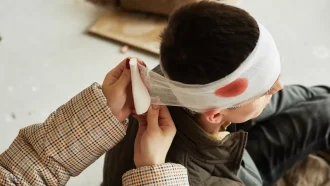
Seasonal Affective Disorder Self-Care
Coping With The Effects of SAD
Table of Contents
Do you find yourself feeling sad or depressed as winter approaches each year? If so, you may have a case of seasonal affective disorder, or SAD. SAD is a serious illness that requires the attention of a mental health professional. However, if you have this disorder, you can also do things on your own to cope with its impact. In fact, seasonal affective disorder self-care is recommended by most experts.
This self-care does not replace formal treatment. Still, it can help make it much easier for you to develop a reliable sense of well-being. By educating yourself about SAD and your self-care options, you bring this important goal within reach. Keep reading to learn more about these crucial topics.
What Is Seasonal Affective Disorder (SAD)
Seasonal affective disorder is a form of depression associated with significant changes in available daylight. It occurs most often when light levels drop during the fall and winter. But it can also occur in late spring and early summer when light levels reach their maximum. Doctors refer to these two variations, respectively, as winter-pattern SAD and summer-pattern SAD.
People affected by SAD actually have a form of major depression. However, this depression occurs in specific parts of the year, not year-round. Be aware that it is possible to have both SAD and additional major depression. People with year-round depression symptoms have increased risks for SAD. During the fall/winter or spring/summer, their number of depressive episodes typically go up. Most people with SAD feel its annual effects for a period of four or five months. This is true whether or not they also experience depression throughout the year.
Causes of Seasonal Affective Disorder
The causes of seasonal affective disorder are only partially understood. For any given person, a number of factors may or may not contribute. Examples of these potential contributing causes include:
- Lowered activity of serotonin, a mood-regulating chemical inside your brain and body
- Actual drops in your serotonin levels triggered by limited light exposure
- Excessive production of the sleep-regulating chemical melatonin
- Vitamin D deficiency resulting from reduced exposure to daylight
- A negative outlook on the approach of the winter season
Your genetics and place of residence may also be important. In some cases, SAD is known to appear in multiple generations of the same family. Your risks may also rise the further north you live.
Symptoms and Signs of SADs

The core symptoms of SAD are more or less identical to those of classic major depression. They include things such as:
- Daily feelings of depression or deep sadness
- Low energy levels
- Unexplained feelings of agitation or sluggishness
- Problems thinking straight or concentrating
- A loss of interest in things you normally like to do
- Strong, negative feelings such as guilt, worthlessness or hopelessness
- Recurring thoughts of suicide or dying in general
Each subtype of SAD also has its own additional telltale signs or symptoms. For the disorder’s winter-pattern form, these indicators can include:
- Excessive sleeping
- Weight gain triggered by the overeating of carbs and other foods
- An increasing tendency to withdraw from social contact
Signs and symptoms associated with summer-pattern SAD include:
- Problems falling asleep or staying asleep
- Weight loss triggered by a drop in your typical appetite
- Unusual feelings of agitation and/or restlessness
- Uncharacteristic bouts of violent behavior
There is also a time-based aspect to a diagnosis of SAD. Whether it occurs in fall/winter or spring/summer, you must experience symptoms two or more years in a row.
When to Seek Professional Help
Professional treatment is critical for all forms of major depression. This is the only way to:
- Receive an accurate diagnosis
- Gain access to effective medication and therapy
- Maximize your chances of recovering your sense of wellness
If you suspect you are affected by SAD, talk to your doctor as soon as possible. This conversation will help start the process that leads to an accurate diagnosis. Doctors may diagnose you on their own. They may also refer you to someone who specializes in depression treatment like our facility at Emerald Isle Health & Recovery.
Unfortunately, SAD is overlooked or misdiagnosed far too often. To avoid this possibility, you may want to start by talking to an experienced mental health specialist. Trained specialists know how to spot even relatively subtle symptoms of the disorder. They also know how to eliminate other potential diagnoses and focus on what is really happening in your case.
In some cases, emergency help is needed for people with SAD and other forms of depression. As a rule, this occurs when the affected person is:
- Thinking about suicide
- Actively planning suicide
- In immediate danger of attempting suicide
The Importance of Seasonal Affective Disorder Self-Care
Even if you have a formal SAD treatment plan, your doctor will almost certainly recommend self-care options, as well. This is true because seasonal affective disorder self-care is viewed as an important part of an effective recovery. Unless you develop a reliable routine for everyday life, you may find it more difficult to function. You may also find it harder to gain some of the potential benefits of formal treatment.
Tips for Self-Care of SADs

To practice successful self-care, you must know your warning signs for SADs. This not only means knowing the potential symptoms of SAD-related depression in general. It also means knowing the potential symptoms of your particular subtype of the disorder. In addition, it means knowing which of those symptoms are most likely to affect you.
What types of self-care options are commonly recommended? For winter-pattern SAD, one frequent option is making sure your indoor surroundings provide enough daylight. Steps you can take to do this include:
- Keeping your curtains or blinds open during the day
- Removing any outdoor obstructions that block your windows
- Sitting near an unobstructed window as often as possible
Another great way to make sure you are exposed to enough light is to venture outside. When it comes to easing the impact of SAD, this is most useful two hours or less after you wake up. Whether you go for a stroll or stay in one place, the added sunlight may help reduce your winter-pattern symptoms. This is true even on cloudy or overcast days.
It’s also important to get plenty of exercise. Why? Exercise is known to help ease your anxiety and stress levels. This is a big deal because both anxiety and stress can make your depression symptoms worse. Staying fit and healthy may also provide a notable boost to your feelings of self-esteem.
In addition, experts recommend maintaining a consistent sleep schedule. This is helpful for minimizing the sleep issues associated with both winter- and summer-pattern SAD. However, it provides the greatest benefits for people with the fall/winter form of the disorder.
There are also other important aspects to a comprehensive seasonal affective disorder self-care plan. That includes such things as:
- Eating well
- Consistently following your current formal treatment plan
- Making the effort to socialize with friends and family
- Learning how to effectively manage your stress levels
You can learn stress management techniques in a class designed for that purpose. You can also participate in stress-relieving activities such as tai chi and yoga.
Make Sure to Schedule Time for Self-Care
In a perfect world, you would have plenty of time to follow your SAD self-care routine. However, chances are that you must balance your self-care efforts with other important, time-consuming activities. In such circumstances, how can you help ensure that self-care remains a top priority?
One common option is to schedule time for self-care well in advance. Once you have established your schedule, do your best to stick to it. The longer you do this successfully, the easier it will probably become. Eventually, you may find that your self-care practices have become reliable fixtures of your everyday routine.
When Should Your Annual Self-Care Routine Begin
As a rule, if you have SAD, you cannot prevent it from recurring year to year. It also may not be possible to start formal treatment early in preparation for what is to come. Given these facts, when should you start your annual seasonal affective disorder self-care routine?
The good news is that many self-care techniques are beneficial throughout the year for reasons other than SAD prevention. That includes things such as eating well, exercising regularly, and maintaining a regular sleep schedule. It also includes managing your daily stress levels. If you use these techniques year-round, you may find that your annual transition into SAD self-care is fairly seamless.
Get More SAD Self-Care Tips at Emerald Isle
Need more advice on self-care options for SAD? Just contact the knowledgeable specialists at Emerald Isle. We are happy to help you create a routine that works for your particular situation. Emerald Isle also offers a full slate of services for depression treatment. This is true whether you are affected by SAD or another depressive disorder.
Our many treatment options also include help for the combined effects of depression and substance problems. This is critically important since these two common mental health issues often occur together. For more information on how we can support your recovery from seasonal or year-round depression, call us today.
REFERENCES:
- National Institute of Mental Health: Seasonal Affective Disorder
- American Psychiatric Association: Seasonal Affective Disorder (SAD)
- Mayo Clinic: Seasonal Affective Disorder (SAD) – Diagnosis








